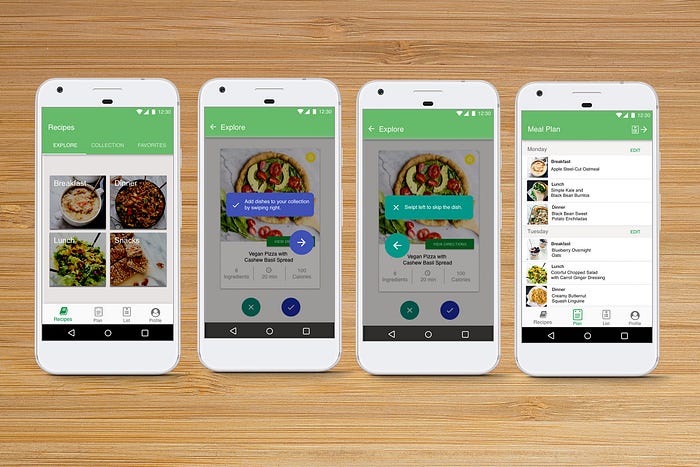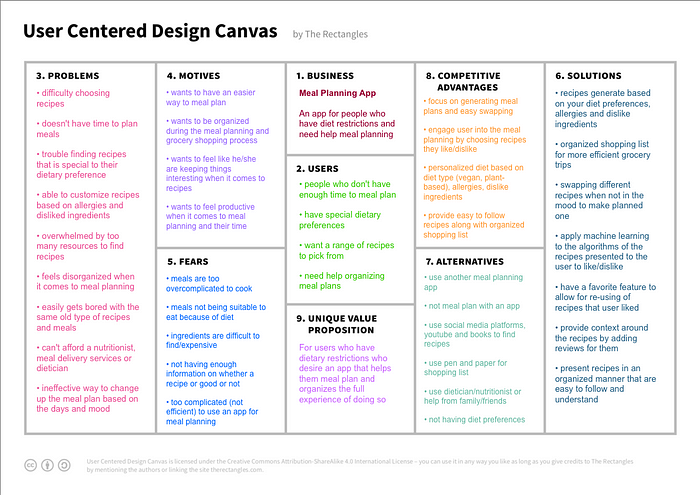
Meal Planning App: Case Study
Tinder for Recipes
Goals/Objectives — Why this project?
Back in January, I was watching a documentary on healthy eating and I realized that I needed to change my eating habits. I made the decision to go vegan and while doing so I learned of things that frustrated me along the way and the main one was meal planning. I sat down every sunday and went through cookbooks, apps, using google and it was kind of draining. I started thinking, how and what can I do to make this easier, I knew I wanted it to be app, but I needed to figure out what kind of features this app needed to have in order to successfully accomplish making meal planning easier, especially for vegan and other diets preferences. This case study is my journey on how I used the design process to explore this aspect.
Research — Competitive Analysis
To get started I decided to dive into the research aspect. Since I had already used apps in the past for my current problem, I felt exploring other equivalent products or services out there for my problem was the next step, which lead me to completing a Competitive Analysis. I felt this was a good starting point because it helps know the market, product/goals better, how effective they are and understand the competition and get actionable insights. Also, exploring a competitor’s product gives an opportunity to discover what is working well and what common standards are being used (i.e. if all of your competitors are offering specific functionality, users will likely expect your product to offer similar functionality)
Identifying the competition wasn’t difficult, I simply just googled “meal planning apps” and also used some of my own apps that I had experience with. Based on Jamie Levy’s UX Strategy book, when doing a competitive analysis she mentioned that you want to identify the direct and indirect competition. Direct competition consists of those people and companies who are doing what you do already. You share the same customers (or better still, you want their customers to become yours) and they offer the same product or service that you do. Indirect competition is composed of those who offer something similar to what you offer. Maybe it is not the first part of their product or service but the second or third.

UX Strategy — User Centered Design Canvas
Based on my findings from my competitive analysis I felt confident into moving to the next step of designing my product which was coming up with a strategic plan and help build competitive advantage into my product.
I chose to use the User Centered Design Canvas tool as my strategic plan because it focuses on both the user side and the business side. This tool was introduced in the article on UX Magazine: Introducing User Centered Design Canvas. There are 9 fields that capture information about the users and the business or product. The left side focuses on the user and consists of: problems, motives and fears, this helps with understanding the users and define their goals. The right side focuses on the business, the solutions, alternatives and competitive advantages. Lastly, the center column gathers the business, the users and Unique Value Proposition.

Design Thinking Process

Empathize
Provisional Persona
To start off, I created a provisional persona of a potential user for the meal planning app based on the competitive analysis I did and my understanding of how I use other meal planning apps. This persona was created with the assumptions and not fully-research based but it was something I came back to throughout my project that helped guide my design decisions and priorities.

Define
Now that I have my starting points, I decided to run a survey to gather what people’s experiences are with meal planning. I wanted to validate my provisional persona by asking a wide range of questions. Things I wanted to gather were:
Quantitative
- Type of Diet/Diet Restrictions
- How many people they feed a night and how many nights they cook
- How often they meal plan and why
- What they like and dislike about meal planning and where they get their ideas
- How time spent and features they want in a meal planning service
Qualitative
- Gather their experience with meal planning and their process
- Openness to using a mobile app to meal plan and what feature they would like
Affinity Maps — Based on Qualitative Responses


Some Key Insights from my Research:
People want a variety of recipes that are easy to make and follow along to. Want simple ingredients and not complicated recipes. They choose recipes based on their cooking ability. Some vary their recipes they have chosen by a theme or based on a main protein.
People have many methods of searching for recipes and they are in multiple places so they do have a “saved” recipe folder. Google was the most popular option for people that ate meat but non-meat individuals referenced Pinterest and blogs they have found previously.
People select recipes based on a number of factors: what they already have, what produce is in season, how long prep time is and cooking around their schedule, how many stores they would need to go to, and sales going on currently.
People wanted many features in a meal planning app. Some were: multiple options meals per say whether than one, be able to remove/replace a recipe/want alternatives, number of calories, prep time, healthy recipes, a feature that allows you to look across the week all at once, be able to “ban” ingredients/select diet and a shopping list.
Ideate

Prototype
https://xd.adobe.com/embed/6e3a9d6a-dd5a-4213-995e-3f5993afcf12/

Validate
To validate my proposed design solutions, I tested my prototype on 5 people. Through testing, I discovered although my design was clean and simple, users did not easily recognize the icons that were call to actions. I also had one participant say “oh, it’s like tinder for recipes!”. Which I thought was clever and amusing because that’s kinda what it is.

Thanks for reading!
As a UX Designer, this case study taught me that although I am apart of the intended target audience, my experience does not solely reflect everyone else’s. Based on the research I gathered, I must keep their other experiences found during the research process within the design features. The use case of this project is something I enjoyed doing the research I am passionate about it and it would be awesome for this to one day be a real app for people who are vegan and etc.
Check out more of my work on my portfolio! Interested in working together or looking for a UX designer to hire? Contact me through LinkedIn or email me at allie.serd@gmail.com.
Feel free to leave comments below. ❤

